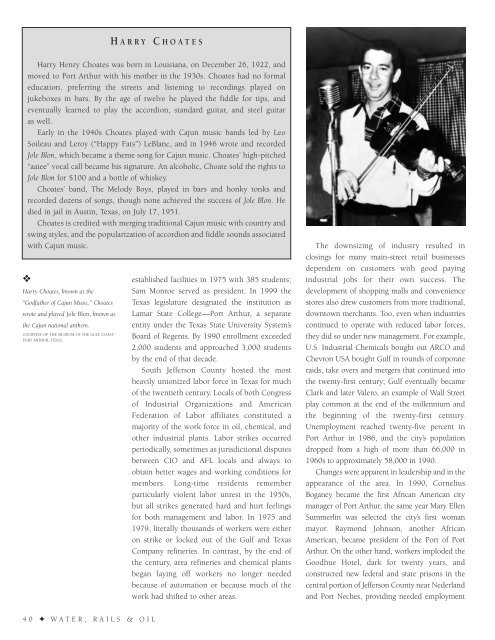Water Rails & Oil - Historic Mid & South Jefferson County
An illustrated history of the Mid and South Jefferson County area, paired with the histories of companies, families and organizations that make the region great.
An illustrated history of the Mid and South Jefferson County area, paired with the histories of companies, families and organizations that make the region great.
You also want an ePaper? Increase the reach of your titles
YUMPU automatically turns print PDFs into web optimized ePapers that Google loves.
H ARRY<br />
C HOATES<br />
Harry Henry Choates was born in Louisiana, on December 26, 1922, and<br />
moved to Port Arthur with his mother in the 1930s. Choates had no formal<br />
education, preferring the streets and listening to recordings played on<br />
jukeboxes in bars. By the age of twelve he played the fiddle for tips, and<br />
eventually learned to play the accordion, standard guitar, and steel guitar<br />
as well.<br />
Early in the 1940s Choates played with Cajun music bands led by Leo<br />
Soileau and Leroy (“Happy Fats”) LeBlanc, and in 1946 wrote and recorded<br />
Jole Blon, which became a theme song for Cajun music. Choates’ high-pitched<br />
“aaiee” vocal call became his signature. An alcoholic, Choate sold the rights to<br />
Jole Blon for $100 and a bottle of whiskey.<br />
Choates’ band, The Melody Boys, played in bars and honky tonks and<br />
recorded dozens of songs, though none achieved the success of Jole Blon. He<br />
died in jail in Austin, Texas, on July 17, 1951.<br />
Choates is credited with merging traditional Cajun music with country and<br />
swing styles, and the popularization of accordion and fiddle sounds associated<br />
with Cajun music.<br />
❖<br />
Harry Choates, known as the<br />
“Godfather of Cajun Music.” Choates<br />
wrote and played Jole Blon, known as<br />
the Cajun national anthem.<br />
COURTESY OF THE MUSEUM OF THE GULF COAST,<br />
PORT ARTHUR, TEXAS.<br />
established facilities in 1975 with 385 students;<br />
Sam Monroe served as president. In 1999 the<br />
Texas legislature designated the institution as<br />
Lamar State College—Port Arthur, a separate<br />
entity under the Texas State University System’s<br />
Board of Regents. By 1990 enrollment exceeded<br />
2,000 students and approached 3,000 students<br />
by the end of that decade.<br />
<strong>South</strong> <strong>Jefferson</strong> <strong>County</strong> hosted the most<br />
heavily unionized labor force in Texas for much<br />
of the twentieth century. Locals of both Congress<br />
of Industrial Organizations and American<br />
Federation of Labor affiliates constituted a<br />
majority of the work force in oil, chemical, and<br />
other industrial plants. Labor strikes occurred<br />
periodically, sometimes as jurisdictional disputes<br />
between CIO and AFL locals and always to<br />
obtain better wages and working conditions for<br />
members. Long-time residents remember<br />
particularly violent labor unrest in the 1950s,<br />
but all strikes generated hard and hurt feelings<br />
for both management and labor. In 1975 and<br />
1979, literally thousands of workers were either<br />
on strike or locked out of the Gulf and Texas<br />
Company refineries. In contrast, by the end of<br />
the century, area refineries and chemical plants<br />
began laying off workers no longer needed<br />
because of automation or because much of the<br />
work had shifted to other areas.<br />
The downsizing of industry resulted in<br />
closings for many main-street retail businesses<br />
dependent on customers with good paying<br />
industrial jobs for their own success. The<br />
development of shopping malls and convenience<br />
stores also drew customers from more traditional,<br />
downtown merchants. Too, even when industries<br />
continued to operate with reduced labor forces,<br />
they did so under new management. For example,<br />
U.S. Industrial Chemicals bought out ARCO and<br />
Chevron USA bought Gulf in rounds of corporate<br />
raids, take overs and mergers that continued into<br />
the twenty-first century; Gulf eventually became<br />
Clark and later Valero, an example of Wall Street<br />
play common at the end of the millennium and<br />
the beginning of the twenty-first century.<br />
Unemployment reached twenty-five percent in<br />
Port Arthur in 1986, and the city’s population<br />
dropped from a high of more than 66,000 in<br />
1960s to approximately 58,000 in 1990.<br />
Changes were apparent in leadership and in the<br />
appearance of the area. In 1990, Cornelius<br />
Boganey became the first African American city<br />
manager of Port Arthur, the same year Mary Ellen<br />
Summerlin was selected the city’s first woman<br />
mayor. Raymond Johnson, another African<br />
American, became president of the Port of Port<br />
Arthur. On the other hand, workers imploded the<br />
Goodhue Hotel, dark for twenty years, and<br />
constructed new federal and state prisons in the<br />
central portion of <strong>Jefferson</strong> <strong>County</strong> near Nederland<br />
and Port Neches, providing needed employment<br />
40 ✦ WATER, RAILS & OIL
















